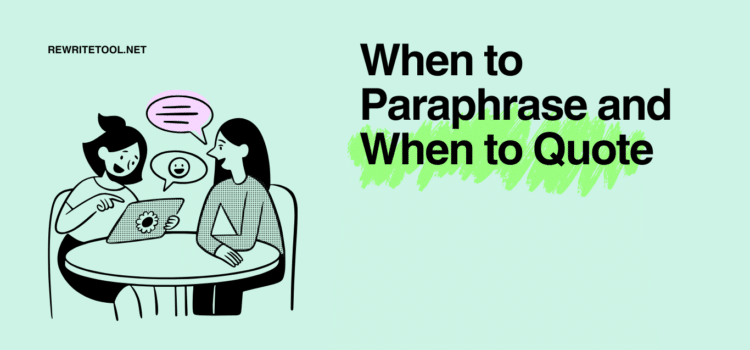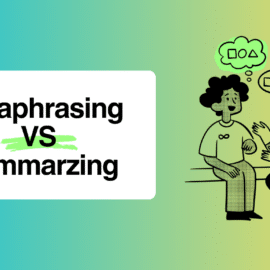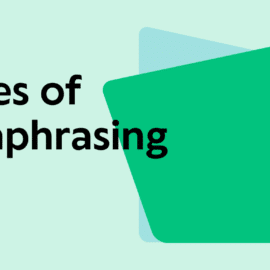
The English language provides us with amazing tools including paraphrase and quotation that can help us to create content with just bit of research easily. Now with the existence of the internet and its overall popularity, people don’t have to go through countless hours of reading books to get information for their research about a subject.
What is Paraphrasing and Quoting?
Paraphrasing involves rewording text to convey the original meaning in a new and unique way, simplifying complex ideas for broader comprehension. It’s a fundamental skill in academia, honed through extensive practice and reading.
By using straightforward language, paraphrasing ensures that readers can grasp the essence of the source material without the need for specialized knowledge. This technique is particularly useful in academic writing, where clarity and accessibility are paramount, allowing researchers to present ideas in a more digestible format for diverse audiences.
Quoting, on the other hand, entails directly replicating the exact words of a source, preserving the author’s original language and context. This method is essential in situations where the precise wording carries significant weight, such as when citing specific data, defining technical terms, or capturing the nuances of an argument.
Quotes are valuable for maintaining the integrity of the original author’s voice and perspective, providing readers with direct access to primary sources and enhancing the credibility of the information presented. When using quotes, it’s crucial to adhere to ethical standards by accurately attributing sources and providing proper citations to support the claims made in the text.
How to Paraphrase a Quote?
To paraphrase a quote effectively, follow these steps:
- Understand the Original Quote: Begin by comprehending the meaning and context of the original quote. Identify the key message or idea it conveys.
- Paraphrase the Quote: Express the essence of the quote in your own words while retaining its original meaning. Focus on simplifying complex language and adjusting the structure to fit your writing style.
- Maintain Accuracy: Ensure that your paraphrased version accurately represents the original quote’s meaning and intent. Avoid altering the message or introducing new ideas.
- Check for Plagiarism: Verify that your paraphrase is sufficiently different from the original to avoid unintentional plagiarism. Use plagiarism detection tools if necessary.
- Cite the Source: Always provide proper attribution to the original source, even when paraphrasing. Include an in-text citation or footnote according to your preferred citation style (e.g., APA, MLA).
By following these steps, you can effectively paraphrase a quote while maintaining clarity, originality, and adherence to ethical writing standards.
When To Paraphrase?
Knowing when to paraphrase is essential for effectively communicating information while maintaining clarity and avoiding plagiarism. Here are some situations where paraphrasing is particularly appropriate:
- Simplifying Complex Texts: When the original text contains technical language or complex terminology that may be difficult for your audience to understand, paraphrasing can help make the content more accessible and reader-friendly.
- Summarizing Lengthy Passages: Instead of quoting long passages verbatim, paraphrasing allows you to condense the information into a more concise form while still conveying the original meaning.
- Avoiding Overuse of Direct Quotes: While direct quotes are valuable for preserving the original author’s exact words, over-reliance on quotes can make your writing appear choppy or fragmented. Paraphrasing allows you to integrate information smoothly into your own writing style.
- Integrating Multiple Sources: When synthesizing information from multiple sources, paraphrasing helps you blend different perspectives and ideas cohesively without relying heavily on direct quotes from each source.
- Adapting for Different Audiences: Paraphrasing enables you to tailor the language and style of the original text to better suit the needs and background knowledge of your specific audience.
- Maintaining Flow and Coherence: Paraphrasing allows you to maintain a consistent flow of ideas throughout your writing, avoiding abrupt shifts that can occur when inserting direct quotes.
- Ethical Considerations: When discussing sensitive or controversial topics, paraphrasing can help you present information in a more neutral or objective manner, avoiding potential misinterpretations that may arise from using direct quotes out of context.
Overall, paraphrasing is valuable for enhancing readability, integrating information seamlessly into your own writing, and demonstrating your understanding of the material while respecting the original author’s work.
When To Cite?
Knowing when to cite your sources is crucial to maintain academic integrity and avoid plagiarism. Here are some guidelines on when to cite:
- Direct Quotes: Whenever you use the exact words or phrases from a source, whether it’s a sentence, a paragraph, or longer excerpts, you must place them in quotation marks and provide a citation.
- Paraphrasing: When you rewrite someone else’s ideas or information in your own words, even if you don’t use their exact words, you still need to acknowledge the original source with a citation. Paraphrasing does not exempt you from citing.
- Specific Information: Whenever you present specific facts, statistics, data, or findings that are not common knowledge, you should cite the source that provides that information.
- Ideas and Concepts: If you discuss or analyze an idea, theory, concept, or argument that originates from a specific source, you should cite that source. This applies even if you’re not directly quoting or paraphrasing.
- Images, Graphics, and Multimedia: Any visual or multimedia content that you use in your work that is not your original creation should be properly cited, including charts, graphs, photographs, videos, etc.
- Borrowed Theories or Frameworks: If you use a theoretical framework, methodology, or model developed by someone else in your research or writing, cite the original source.
- Common Knowledge Exclusions: Information that is considered common knowledge, such as widely known facts (e.g., dates of historical events, basic scientific principles), does not require citation.
Remember, citing your sources not only gives credit to the original authors and acknowledges their contributions but also lends credibility to your own work by demonstrating thorough research and supporting your arguments with authoritative sources.
Other Helpful Resources:
- Different types of paraphrasing
- Summarizing vs paraphrasing
- Paraphrasing examples
- Paraphrasing and summarizing examples


